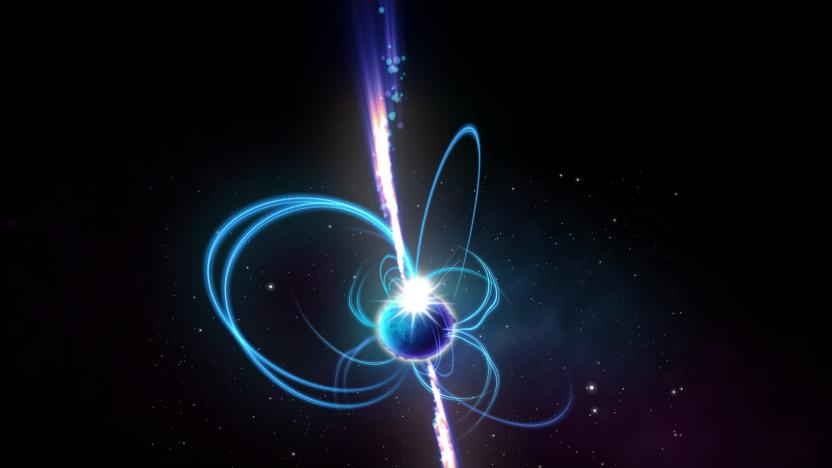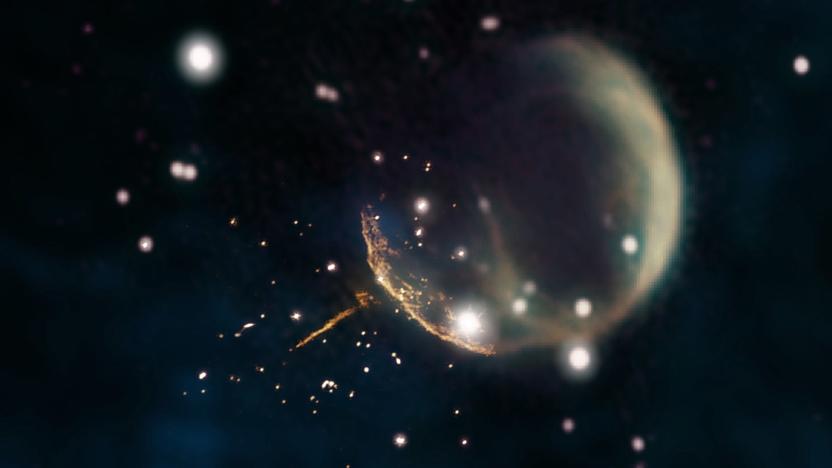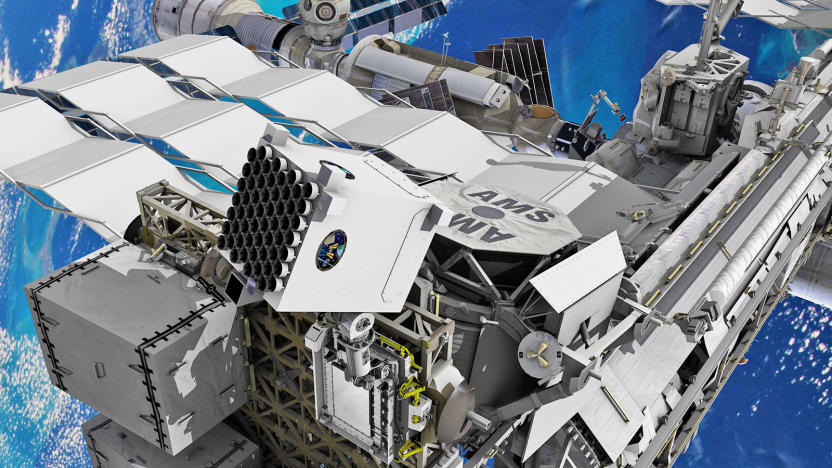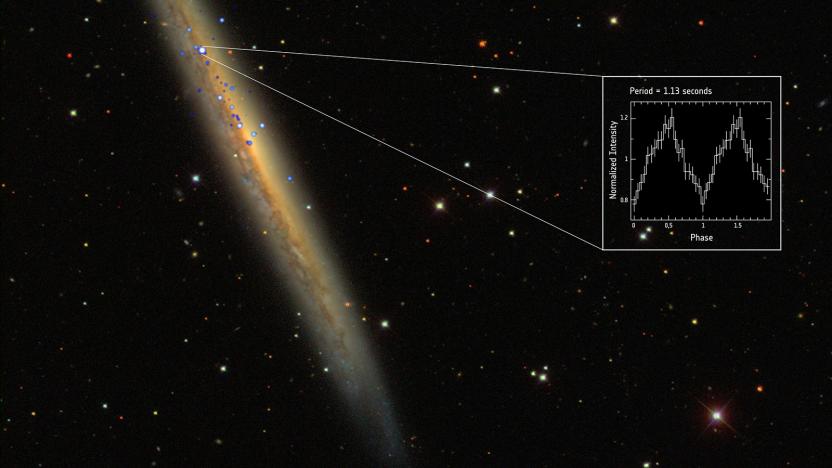pulsar
Latest

Strange Milky Way object sends radio bursts a minute at a time
A strange object in the Milky Way galaxy is sending radio bursts a minute at a time, and it's not necessarily a neutron star.

'Cannonball' pulsar points to the supernova that formed it
Astronomers have clocked a spinning star at 2.5 million MPH and grabbed an image that leaves no doubt where it came from. Using NASA's Fermi Telescope and the Karl G. Jansky Very Large Array (VLA), a team of scientists imaged pulsar J0002, originally discovered by citizen science project Einstein@Home. What makes it look so cool is the clear evidence it came from a recent supernova. "Thanks to its narrow dart-like tail and a fortuitous viewing angle, we can trace this pulsar straight back to its birthplace," said NRAO scientist Frank Schinzel.

NASA is investigating X-Ray navigation in space
X-rays aren't just for investigating artworks or photographing black holes. NASA scientists just used them to demonstrate a new technique: Navigating the stars. In an experiment, equipment mounted on the International Space Station measured radiation beamed out from distant neutron stars in millisecond pulses -- and by timing their arrival, future spacecraft could find their location from deep space.

Watch SpaceX carry NASA's pulsar-observing instrument to the ISS
On June 1st, a SpaceX Falcon 9 rocket will carry supplies and new instruments to the ISS, including one designed to observe some of the strangest objects in the universe: neutron stars or pulsars. The Neutron Star Interior Composition Explorer (NICER) will be installed outside the ISS, where it will look for and study the extremely dense objects. Neutron stars begin their lives as stars around seven to 20 times the mass of our sun. When they collapse and cause a supernova explosion, they turn into a sphere that's only 12 miles across, with twice the mass of our sun squeezed inside. They're also called "pulsars" when they rotate hundreds of times per second.

Newly discovered star remnants are the brightest ever seen
The European Space Agency's XMM-Newton X-ray observatory discovered a pulsar that's a thousand times brighter than researchers had previously thought possible. Officially dubbed NGC 5907 X-1, the pulsar is 10 times brighter than the previous record holder. This means that in one second it puts out the same amount of energy our Sun releases during the course of 3.5 years. The pulsar, or spinning remains of what used to be a massive star, is also the furthest ever observed. Its light traveled 50 million light years before the spacecraft noticed it.

Astronomers are using pulsars to spot gravitational waves
Earlier this month scientists detected gravitational waves, but it wasn't easy. Because of the tiny forces involved, it took us nearly 100 years to confirm Einstein's original prediction that ultra-massive objects like black holes could send ripples across space-time. A team of astronomers from a group called NANOGrav thinks it can use stable pulsar signals to track tiny movements in the Earth when it's jostled by gravitational waves. "Detecting this signal is possible if we are able to monitor a sufficiently large number of pulsars spread across the sky," says Stephen Taylor from NASA's Jet Propulsion Laboratory. "The smoking gun will be seeing the same pattern of deviations in all of them."

Astronomers accidentally discovered the brightest pulsar on record
Remember NuSTAR, the specialized space telescope NASA designed specifically to study black holes? It just found something much, much brighter. Astronomers at NASA have stumbled upon what appears to be the most luminous pulsar ever discovered, but they almost mistook it for a black hole. After measuring the dead star's output, they found it was outputting as much energy as 10 million suns -- shockingly powerful, considering how much smaller it is than our own star. Astronomers aren't sure why the pulsar is so bright, but will continue to study in hopes of learning how common or uncommon this kind of pulsar is. The discovery kind of shakes up what theorist knew about black holes and ultraluminous x-rays, underlining how little we really know about the universe out there. Check out NASA's gallery of images at the source link below.

Australia Square Kilometre Array Pathfinder goes live as the world's quickest radio telescope
Australia's Shire of Murchison is quickly becoming a hotbed for radio telescopes. As of of Friday, the territory is operating the world's fastest radio telescope in the form of the Australia Square Kilometre Array Pathfinder (ASKAP). The 36-antenna grid's eventual use of six phased array feeds, each with 188 receivers, will let it scan a field of view 150 times larger than the moon's visible area while processing that information much faster than a typical single-pixel radio telescope feed -- CSIRO estimates that an image of the Centaurus A galaxy that would take 10,000 hours to process with rivals should take five minutes with ASKAP. Ultimately, the array should grow to 60 antennas as part of the Square Kilometer Array, which includes South Africa in its hunt for pulsars, quasars and other unique parts of the universe. Just don't get your hopes up for booking alien listening sessions anytime soon. Commissioning started virtually as soon as the ribbon was cut, and scientists have already scheduled their usage slots for the next five years. We're sure we'll get over any frustration when we see the first ASKAP results published within the next year.

Radio astronomy pioneer Sir Bernard Lovell dies at 98
Astronomy just lost one of its vanguards, as Sir Bernard Lovell has died at 98. The UK-born scientist was best known as a cornerstone of radio telescope development. While he wasn't the first to leap into the field, he established the University of Manchester's Jodrell Bank Observatory to study cosmic rays in 1945 and organized the construction of what would ultimately be called the Lovell Telescope -- a radio telescope so large and useful that it's still the third-largest steerable example in the world, 55 years after it was first put into action. His work helped track some of the earliest spacecraft and was instrumental in confirming the first discovered pulsars and quasars. On top of his most conspicuous achievements, Sir Lovell played an important role in developing airborne radar during World War II and was lauded for having scientific curiosity long after he hung up his Jodrell director's hat in 1980. Science will be poorer without him. [Image credit: NASA; thanks, Darren]

IBM cluster powers Murchison Widefield Array's radio telescope, answers mysteries of the universe faster than ever (video)
Radio telescope operators have as much of a problem coping with the avalanche of data as getting that information in the first place. The Victoria University of Wellington is all too aware and is leaning on IBM for a powerful (if very tongue-tying) iDataPlex dx360 M3 compute cluster to sift through the deluge at the upcoming Murchison Widefield Array. Combined, the 4,096 array antennas probing deep space and solar atmospherics will have the Xeon-based cluster tackling signal data to the tune of 8GB per second, and about 50TB per day -- that's a Nexus 7's worth of astronomy faster than you can sneeze, folks. A 10Gbps network connection will feed the results to Perth to save scientists a roughly 435-mile trek. Construction is still in mid-stride, but the $51 million Australian ($52.2 million US) being spent on the Murchison array may be worthwhile if it helps solve the riddles of star formation and solar flares.

Seagate Pulsar XT.2 and Pulsar.2 SSDs target enterprise, reliability-obsessed consumers
Seagate has just taken the wraps off a slew of fresh enterprise storage drives, highlighted by a pair of new Pulsar SSDs. The MLC NAND-equipped Pulsar.2 is capable of 6Gbps speeds over SATA, while the 2.5-inch XT.2 uses SLC memory and a 6Gbps SAS connection, and both are unsurprisingly touted as being the fastest and finest guardians you can buy for your company's data. Seagate sees the use of MLC flash on the Pulsar.2 as a major advantage in lowering costs, while its data-protecting and error-correcting firmware is expected to maintain the high levels of data integrity required in this space. No price is actually given to validate Seagate's claims of a breakthrough price / performance combination, but both of its new SSDs should be available in the second quarter of this year. The XT.2 is already shipping out to OEMs, along with its 360MBps read and 300MBps write speeds. There are also new Savvio and Constellation HDDs from the company, but you'll have to read the 1,400-word essay press release after the break to learn more about them.

Pulsar clocks spin closer to reality
Contrary to popular legend, Pulsar wristwatches don't use the light of dying stars to keep time. However, if researchers at the University of Manchester are correct, the strobe-like effect generated by a collapsed star's spin may indeed be the most accurate clock (sorry, atoms) available to mankind. While pulsars have long been studied for insight into the nature of time and gravity, their patterns weren't as regular as scientists would like, but the U of M team believe that's because the stars are actually swapping between two different states, each with their own rotation speed. By correcting for the difference when the hunk of burning gas puts on the brakes, they can make measurements far more precise -- meaning a greater understanding of the fabric of space-time for the brainiacs, and if we're lucky, reliable pulsar clocks within our lifetime.

Seagate's first Pulsar SSDs ready to blast the enterprise
We first heard of Seagate's plans to enter the SSD market way back in mid 2007 and then again in 2008. Here we are in the final days of 2009 and guess what: the first Seagate SSD has been announced. Unfortunately, Seagate's 2.5-inch SATA Pulsar SSD targets the raised-floor crowd locked away in your corporate data center, not you directly. The SLC-based Pulsar tops out at 200GB and claims a peak performance of 30,000 read IOPS and 25,000 write IOPS and a 240MBps sequential read and 200MBps sequential write -- damn quick compared to Samsung's enterprise-class SSDs released last year clocking 100MBps sequential reads and 80MBps writes. Hopefully, we'll see Seagate push into the consumer sector once they finish milking corporate IT budgets, or what's left of 'em.





